It happened on Thursday, September 6th. It was a gorgeous day and I decided to enjoy a day of fishing at Hopkinton Lake, targeting black crappies.
When I got up, I packed a lunch, loaded the vehicle with all necessary equipment: electric motor, canoe paddles, fishing rods and bag, depth finder, life jacket, fire extinguisher and the cement weights for the bow.
The next step was to hook the canoe trailer to the vehicle, load the canoe on board and tie it down.
With that done, I started out for Hopkinton Lake, in Hopkinton.
As I got to Pages Corner, on Route 77, I stopped at the local store for a coffee.
It was then that I discovered I had forgotten my boots. As I headed back home, I wondered if perhaps this was an indication that today was not meant for fishing.
Finally arriving, I picked up my boots and again headed back for the lake.
My usual launch site was the Stumpfield Boat Launch.
As I headed down Stumpfield Road, I met up with a friend, Marcia Evans, who runs an equine riding stable.
As I stopped the vehicle, I could see officers from the Army Corp of Engineers just down the road at the lake access gate.
Marcia said, "They’re closing the lake down, Bob. There’s a problem of some sort."
I suggested we go down and talk to them. I parked, Marcia got her electric golf cart and we rode down to talk with the officers.
They confirmed the nightmare, "Yes, we have closed the lake to all usage because there is a serious flow of Cyanobacteria on the lake, due to the horrific lack of rain and warm weather.
We will have to keep the lake closed until such time as enough rain comes to dissolve this blue-green algae. It is very dangerous to humans, as well as animals," the lady officer stated.
"It would not be safe to catch and release fish, or even eat a lunch once your hands get wet."
Great, I thought. How many other water bodies are also infected with Cyanobacteria right
now? Another day gone bad. Marcia and I returned to her barn and I departed again for home.
The next question I had to deal with was, "Where could I fish in safety now?"
No luck o’ the Irish here!
According to the New Hampshire Department of Environmental Services, the presence of cyanobacteria in the recreational waters of New Hampshire’s lakes and ponds is of great concern.
Blooms of this primitive algae have caused adverse health effects and even death!
Cyanobacteria blooms are aesthetically displeasing in sight, odor and taste, as well as potentially toxic to domestic animals, livestock, waterfowl and humans.
The DES says that many cyanobacteria produce toxins (collectively referred to as cyanotoxins) that may be released into the water when cells die or are consumed by organisms in the food chain.
There are four common cyanobacteria to New Hampshire’s lakes and ponds that produce toxins.
These toxins may be hepatotoxins (liver and kidney), neurotoxins (central nervous system) or dermatotoxins (skin irritants) capable of causing both acute and chronic illnesses.
Acute effects, such as skin and mucous membrane irritations, can occur after short term exposure with water containing these toxins.
Chronic effects, such as liver, kidney and central nervous system damage can occur over a period of time from ingestion of the infected water containing large amounts of toxins.
N.H. DES says that recreational exposure to cyanobacteria toxins is of major concern.
However, to date, there have been no documented cases of cyanotoxin related illnesses in New Hampshire.
Below is a list of common New Hampshire cyanobacteria, the toxins they produce, routes of exposure and their common side-effects:
Common
Cyanobacteria Species, Toxins and Effects
| Genus |
Common
Toxins |
Exposure |
Side-Effects |
| Anabaena |
Anatoxins
(neurotoxin), Microcystins (hepatotoxin) |
Swimming
(skin contact and swallowing water), showering (if
drawing water from lake), water sports, boating |
Nausea,
vomiting, diarrhea, general malaise, severe thirst, skin
and mucous membrane irritation, staggering, and
paralysis |
| Aphanizomenon |
Saxitoxins
(neurotoxin) |
Swimming
(skin contact and swallowing water), showering (if
drawing water from lake), water sports, boating |
Numbness
of lips and mouth extending throughout the body, motor
weakness, respiratory and muscular paralysis |
| Microcystis |
Microcystins |
Swimming
(skin contact and swallowing water), showering (if
drawing water from lake), water sports, boating |
Nausea,
vomiting, diarrhea, general malaise, severe thirst, skin
and mucous membrane irritation |
| Oscillatoria |
Anatoxins,
Microcystins, Aplysiatoxins (dermatotoxin) |
Swimming
(skin contact and swallowing water), showering (if
drawing water from lake), water sports, boating |
Nausea,
vomiting, diarrhea, general malaise, skin and mucous
membrane irritation |
The New Hampshire Department of Environmental Services Beach Program takes a proactive approach when cyanobacteria blooms or scums appear at public beaches, as they did at the beach at Hopkinton Lake.
A beach advisory is posted when the potentially toxic cyanobacteria species is present and identified as the dominant algae in the cell count.
You can use the tell-tale signs to initially identify Cyanobacteria’s presence in the water. However, it may only be
positively identified to the Genus level by microscopic identification.
| Images
of Cyanobacteria Blooms |
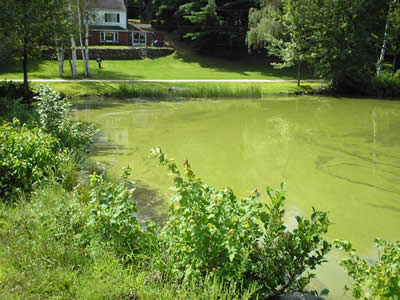
Bow Lake,
Northwood, NH (2006) |
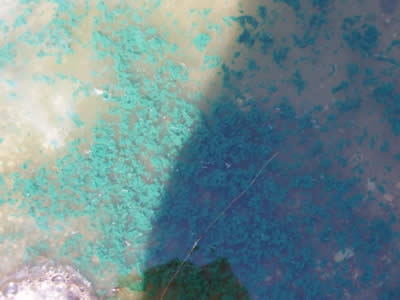
Baboosic
Lake, Amherst, NH (2006) |
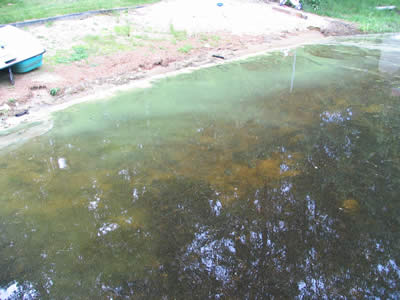
Lake
Monomonac, Rindge, NH (2006) |
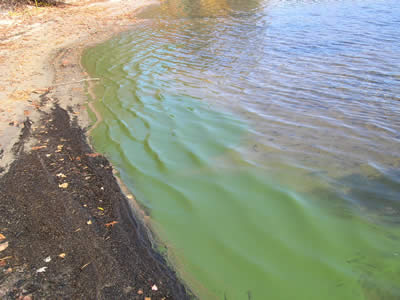
Webster
Lake, Franklin (2005) |
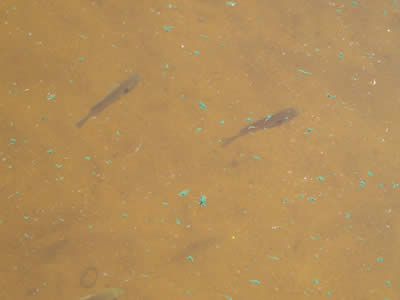
Baboosic
Lake, Amherst, NH |
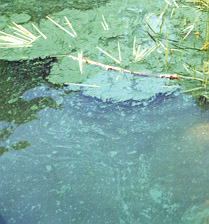
Oscillatoria
bloom |
If you suspect a cyanobacteria bloom is occurring at a lake or pond you intend to fish, swim, boat, etc., you are asked to
call the DES immediately at (603) 271-2457, or e-mail them at watershed@des.state.nh.us and they will conduct a visit.
You may also collect a sample in a clean container (plastic or glass jar) and bring it to DES to identify.
The Department of Environmental Services is located at 29 Hazen Drive, Concord, N.H. 03302.
For directions, go to their website at
www.des.state.nh.us.
If collecting a cyanobacteria or other potentially toxic algae sample, avoid any contact with you skin.
Wear water-proof gloves when sampling and immediately wash all areas of the body where water contact has occurred.
The DES says that cyanobacteria commonly occurs in nearly all of New Hampshire’s waterways.
When present in low numbers, they do not cause recreational or aesthetic problems.
However, when conditions are optimal they may form blooms.
Factors contributing to blooms include nutrient availability, sunlight and temperature.
For more information on cyanobacteria, readers can go to the website:
www.des.state.nh.us/Beaches/cyan
bacteria.html.
|



